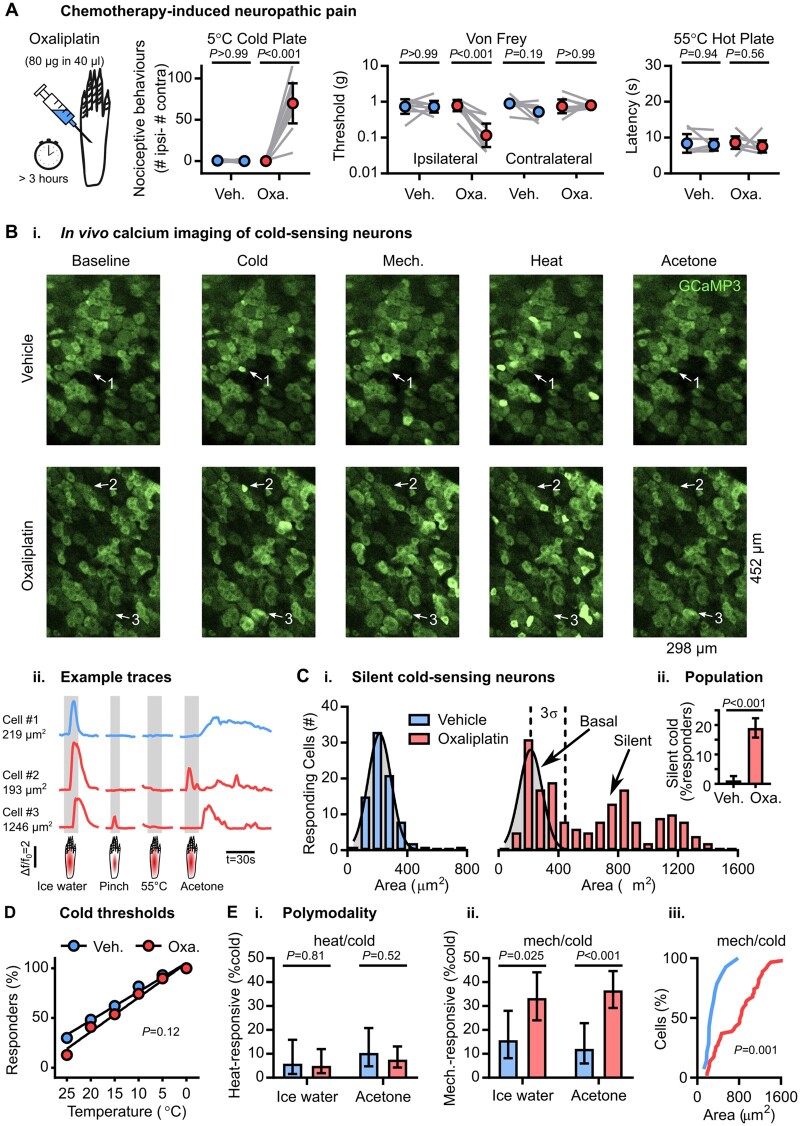Figure 1.
Silent cold-sensing neurons are activated by oxaliplatin. (A) Behavioural testing of the effect of intraplantar oxaliplatin injection on different sensory modalities (cold, mechanical and heat). n = 8 (five male and three female) for vehicle and n = 9 for oxaliplatin (five male and four female). Mean values before and after treatment were compared using repeated measures two-way ANOVA followed by post hoc Sidak’s test. Error bars denote 95% confidence interval. (B) Example images (i) and traces (ii) of cold-responding neurons in vehicle- and oxaliplatin-treated animals expressing GCaMP3. Cell 1 is a small diameter cold-sensing neuron in the vehicle condition, Cell 2 is a small diameter basal cold-sensing neuron after oxaliplatin and Cell 3 is a large diameter silent cold-sensing neuron unmasked by oxaliplatin that also responds to noxious mechanical stimuli. [C(i)] Histograms of the cross-sectional area of all neurons responding to any cold stimulus in the vehicle (top, blue, n = 82) and oxaliplatin (bottom, red, n = 179) groups. The distribution of areas for vehicle was fit by non-linear regression [least squares Gaussian; bin width is 80 µm2; mean = 214.9 µm2, SD (σ) = 77.29 µm2]. This model is plotted over the oxaliplatin data to aid comparison with the dashed line denoting 3 SD from the mean. The difference in the distribution of areas between groups was assessed by Kolmogorov-Smirnov test (P < 0.001). [C(ii)] Bar plot of the percentage of responding neurons classed as silent cold-sensing neurons in the vehicle and oxaliplatin groups. Proportions were compared using a χ2 test, and error bars denote 95% confidence intervals. (D) Relationship between the number of basal cold-sensing neurons and the drop in temperature can be fit by linear regression for both groups. For vehicle, y = −2.883x + 105.2, r2 = 0.9809, n = 87. For basal cold-sensing neurons after oxaliplatin, y = −3.443x + 105, r2 = 0.9802, n = 39. The slopes are not significantly different (P = 0.12). (E) Quantification of the proportion of cold-sensing neurons responding to either heat (i) or mechanical (ii) stimuli in the vehicle and oxaliplatin groups. The proportion of polymodal neurons was compared using a χ2 test, and error bars denote confidence intervals. Ice water: nveh = 51, noxa = 81. Acetone: nveh = 58, noxa = 145. [E(ii)] Cumulative probability plots showing mechano-cold neurons tend to have larger cross-sectional areas in the oxaliplatin group, compared using the Kolmogorov-Smirnov test. nveh = 14, noxa = 62. For this experiment, 383 neurons responding to any stimulus were recorded in eight vehicle-treated mice (five males and three females) and 542 cells were recorded from nine oxaliplatin-treated animals (five males and four females).

